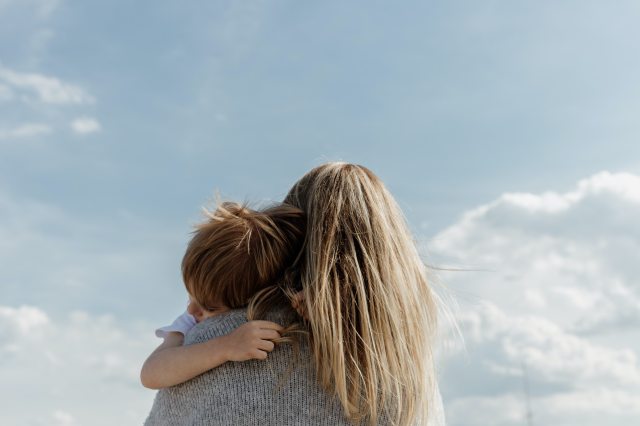Ever since the COVID pandemic began, there is one practice that most people have avoided due to fears of infection. Yet, this simple practice can help people of all ages to be happier and healthier. That practice, which may surprise you, is hugging. Because we aren’t hugging as much, it’s time to think about why hugging is so important and explore options to connect without hugging.
The Power of Hugs
Studies have shown that hugging has several benefits. According to one study, if you wake up in a bad mood, a good hug can ease that cranky feeling. While another study demonstrated that hugs may reduce stress, which, surprisingly, in turn helps you resist upper respiratory infections.
How can something so simple as a hug work such magic? Hugs release oxytocin in the brain. Sometimes called the cuddle hormone, this release of oxytocin reduces stress, lowers blood pressure and reduces one’s heart rate.
We know that infants need holding and cuddling to feel safe and loved. Hospitals even enlist volunteers to come in and hold babies, especially if a newborn is in the hospital for a prolonged period with little or no familial support. Just looking into a baby’s eyes during feeding time or interacting in any way helps a baby’s developmental growth. Also, those of us who have raised children (or grandchildren) know the calming effect of cuddling a baby, especially while relaxing in a rocking chair.
This need for a cuddle or a simple hug doesn’t go away after infancy. When I adopted my second child, at two months, I knew I needed to make up for those first months of life before he joined our family. I always cuddled him at bottle time. I also read to him and rocked him to sleep. When he was a toddler, I would distract him during a meltdown by choosing a book and heading to the rocking chair. By the time he was age three, he recognized my tactic, and when frustrated would say, “Mom, I think I need a book.” Of course, I always obliged. That cuddle with a book dispelled any imminent meltdown.
When it comes to hugging, cultures vary in practice. Some people greet each other with a hug, a smile, and kisses on each cheek, even upon a first introduction. The messages are clear: “I’m happy about meeting you. I welcome you. I trust you. I care enough to open my arms to you.” Other cultures show restraint. A greeting may be limited to a handshake or a formal bow. A hug, whether fleeting or prolonged, may occur only upon leaving an especially good friend or beloved relative. Those warm embraces often come after trust and deep friendships have developed.
But hugs are not always about friendship, family, or affection. Sharing a hug may demonstrate support and empathy to the recipient, even if the friendship isn’t deep, such as after a death or a profound loss. A hug conveys empathy when words just aren’t enough or are difficult to find.
Alternative Ways to Show Affection
Now that we know the power of a hug, what can we do when we must be scrupulous about infection risks or when we aren’t certain about other people’s reactions to hugs? How can we as parents, grandparents, friends or teachers show the affection that says “I value you and support you” when we are masked, washing our hands frequently, opening doors with tissues, and keeping our distance?
And what about those youngsters who just don’t like a good cuddle? We know that children who don’t receive physical touch may struggle with showing affection as adults. And a bear hug can look innocent, but with rival siblings, it could signal power and aggression on the hugger’s part.
During the first year of the pandemic, I homeschooled two grandchildren. One, then age 5, loved to cuddle. Her older sister, age 11, resisted most forms of touch. Because I had the girls overnight much of the school week, I often blew kisses and did air hugs at bedtime, knowing the older sister might resist a hug. Sometimes I simply said, “Hugs. Kisses. Goodnight.” One day, she spontaneously hugged me hard. I said, “Wow! That felt great on my back. Can you give me another back hug?” From that point on, she gave me frequent, therapeutic hugs. Over time, her hugs became less purposeful and more impromptu. However, she still often asks me if I’d like that special “back hug.”
Many parents deal with a tween or teen who no longer wants to share a hug or even hear an “I love you.” One strategy is to find other ways to share physical space that isn’t as invasive. Watch a movie together on the couch, shoulder-to-shoulder. Have a family game night with high fives to celebrate small victories. Read together during homework time. Use emojis that convey affection in texts. Blow kisses. Write little notes to enclose with a backpack or lunch: “Thinking of you. Hugs. Have a great day! Proud of you!”
For adult-to-adult interactions, keep in mind that some people feel awkward about hugging. If a hug is prolonged, it may feel threatening or just “off” at times. It’s up to us to look for cues, to openness to a hug. If you aren’t sure about a hug, or you sense someone might need a hug, preface the interaction with, “May I have (or give you) a quick hug?” If you sense reluctance, mimic an air hug and say, “How about an air hug?”
Other good substitutes to hugging are fist bumps, elbow bumps, making a heart shape with one’s hands, or toe taps. And don’t forget, when wearing a mask, it’s important to smile more broadly than usual. That smile will radiate to your eyes, and it’s almost as good as a hug!











